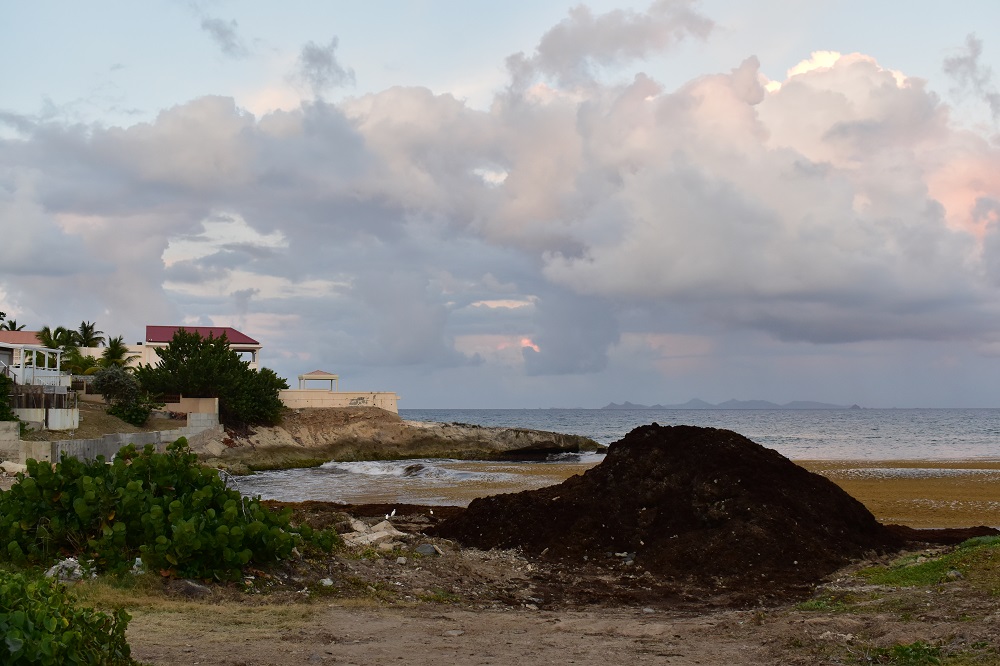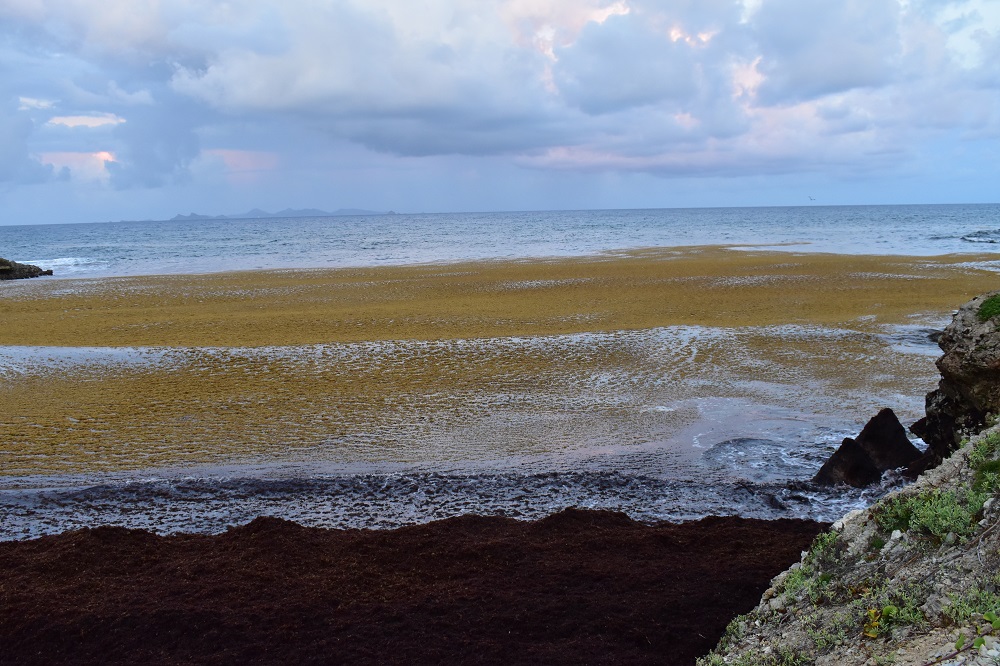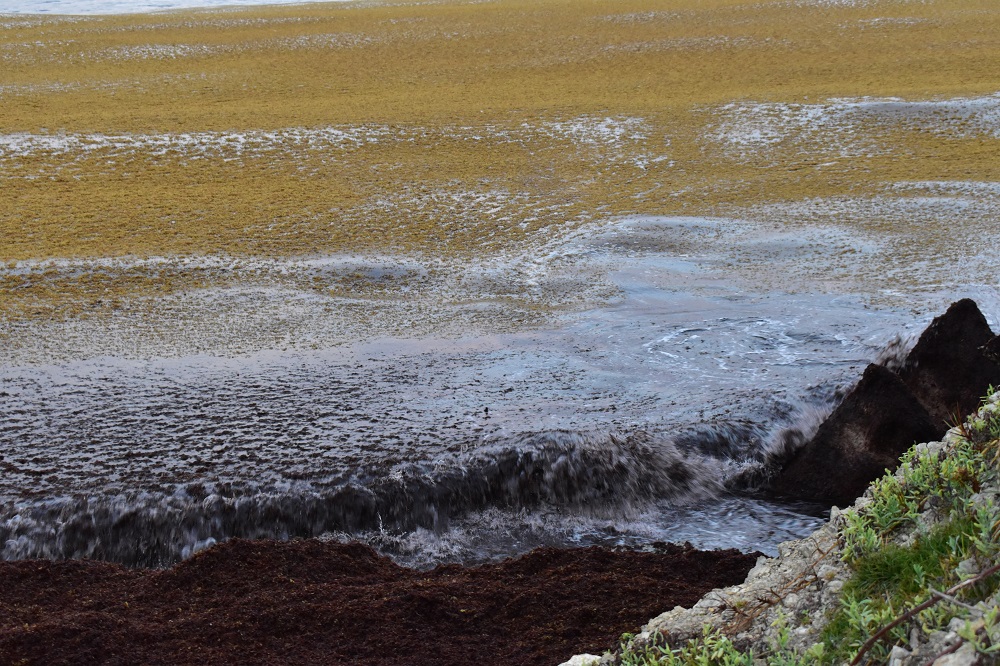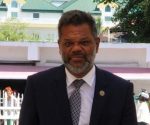“Sargassum invasion is a never-ending story”
PHILIPSBURG — Invited to comment on the clean up campaign the ministry of VROMI is currently undertaking in Pointe Blanche, head of Public Works Claudius Buncamper stated that immediate action had to be taken as the amount of Sargassum that had washed ashore was no longer at a controllable level.
The ministry responsible for environment and infrastructure, VROMI, was forced to take action as the health aspect became urgent with residents complaining about the side effects from the stench of the decaying seaweed. According to reports, complaints centered around breathing issues and allergies.
Asked as to the costs involved and whether these costs were covered in the budget, Buncamper explained that a “few tens of thousands of guilders” were being used to finance the clean up, however, the ministry was using “monies it did not have”. Buncamper expressed the hope that the project would not become too expensive as “we cannot spend what we don’t have.”
The urgency of the need for the cleanup and removal of the seaweed on the beach in Pointe Blanche was not also due to the health impact on the residents, but also the environmental impact had to be seriously taken into consideration as well.
Buncamper explained that he would be meeting with Nature Foundation’s managing director Tadzio Bervoets regarding the turtle nesting areas on the beach that are now under threat from the mounting Sargassum seaweed. “Battling the Sargassum invasion is a never-ending story,” Buncamper said.
When asked what other mitigation plans does the Ministry of VROMI have under consideration seeing that this can become an ongoing campaign if the influx of Sargassum seaweed keeps on coming, Buncamper answered that “clean up is all we can do right now as there is nothing to be done about prevention.”
“A mud bath”
“Luckily, only the eastern side and not the western side of the island is affected.” Buncamper explained, referring to the popular beaches of Great Bay, Little Bay, Kim Sha, Simpson Bay and Mullet Bay which have all being spared from the invasion of the Sargassum seaweed. “If you look at the Oyster Pond area with the channels and ponds blocked by the Sargassum seaweed, it is a mud bath”.
Sargassum Alert Nature Foundation
On Thursday, June 13th, 2019, Nature Foundation issued a Sargassum Alert warning about the large influx of Sargassum currently making landfall on St. Maarten. The foundation also warned about potential health effects.
The alert stated that the Nature Foundation is warning the community that the Sargassum impacts, based on satellite imagery and field surveys, started earlier that week of June and would continue to persist for at least another week: “We have been coordinating our monitoring efforts with our partners in the region and based on weather predictions, satellite imagery and field surveys large mats of Sargassum are impacting the area,” commented Nature Foundation Manager Tadzio Bervoets.
“We have been working closely with our partners in the region and with local stakeholders in monitoring the situation and to find a way to control the amount of the weed washing up on beaches in the case of a significant influx. In the case of an influx we need to find a way to coordinate the removal of the seaweed in order to avoid serious risks to nesting sea turtles and hatchlings while the algae itself can be a hazard to the animals,” continued Bervoets.
The Foundation is also warning residents of areas that are or will be impacted by the Sargassum to take precautions to avoid the negative health effects caused by the decomposing seaweed; “We are advising residents in especially Guana Bay and Point Blanche to keep windows and doors closed as much as possible,” commented Bervoets.
The alert explained that when the Sargassum lands and starts to decompose hydrogen sulfide gas is released. The gas is a colorless, toxic and highly flammable gas and spreads an unpleasant odor much like the smell of rotten eggs; “Inhaling the gas in small doses can trigger irritation of the eyes and the respiratory system, especially among people who are sensitive to it. The groups most at risk are people with respiratory problems, asthma patients, elderly people, babies and pregnant women. Certain animals, especially dogs, are also sensitive to the inhalation of hydrogen sulphide,” continued Bervoets in the alert.
Sargassum is a genus of brown (class Phaeophyceae) seaweed which is distributed throughout the temperate and tropical oceans of the world. Sargassum first plagued St. Maarten in 2011 and 2012, with the Foundation having to warn swimmers to avoid swimming on certain beaches due to the large amount of Sargassum Weed and many beach front residences and hotels having to continuously clean washed up Sargassum.
This year’s Sargassum invasion will be the worst one yet
In regards to the recurring blooms of Sargassum, we are presently facing what Dr. Chuanmin Hu of the College of Marine Science at the University of South Florida (USF) calls the “new normal”. According to reports, this year’s Sargassum invasion will be the worst one yet. Dr. Hu says that 2019 will play out to be “another record year”.
In the Sargasso Sea in the Atlantic, the Great Atlantic Sargassum Belt (GASB) has been described in Science magazine by Dr. Hu and his team as the “largest macroalgal bloom” in the world. The long belt of seaweed composed of floating, photosynthetic brown algae is 5,500 miles long, extending from West Africa to the Caribbean Sea and the Gulf of Mexico.
Since 2011 many islands in the Caribbean have experienced the presence of this influx of Sargassum on their beaches. In June 2018, Barbados declared a national emergency when its economy was seriously threatened by the malodorous and unappealing brown macroalgae.
Unfortunately, the French and Dutch island of Sint Maarten/Saint Martin has not been spared from the invasion of Sargassum weed as well. So much so, that a grant of €375,000 euros from the Antilles Sargassum Plan has been allocated to the Collectivité de Saint Martin by the government of France to cover half of the €750,000 euros needed to buy equipment to pick up the Sargassum. The Collectivité of Saint Martin is financing the other 50%.
Bearing in mind the time needed to order and receive these equipment and the additional time required to train the staff, the Collectivité of Saint Martin voted, during an Executive Council meeting held on July 3rd, to award contracts to local companies to manage the removal of the Sargassum at six different locations.
According to a news release from USF’s oceanographer Dr. Hu, the months of April through July will represent a high season of Sargassum as a spike will be recorded in that period, decreasing only by the end of October.
###
Photos by photo journalist and contributing writer, Sarina Alexander.

























